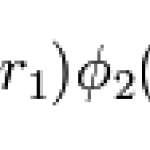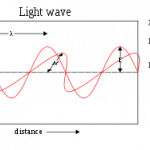
A few days ago we had an interesting discussion about the actual nature of light waves with respect to the informal qualitative presentation of light waves found in intro textbooks. Because I have the best set of physics blog readers in the world, a fascinating discussion ensued with CC and Neil among others. One of the points that was brought up was polarization, by more than one commenter:
How do polarized lenses work then? I was always under the impression that they worked on the fact that light waves had a physical 'up and down' movement.
And I'm not at all surprised that this…
Continuing from yesterday's post on approximation methods in quantum mechanics, here's another common method worth a close look. It's one of my favorites, because it's a rare technique in which you can just make something completely up from thin air and it will very probably work well nonetheless.
Let's say you have a particle floating around in some potential. Maybe it's a perturbed square well, an anharmonic oscillator, or just about any weird potential you can think of. You have no idea what the actual wavefunctions are for the potential. After all, even simple solvable potentials…
We haven't done an actual straight-up physics problem in a while, much less one above the level of undergraduate freshman physics. There's a reason: it's roughly as niche as it's possible for an internet post to be. But on the other hand, surely someone ought to do it every once in a while. So here we go with a roughly 3rd-year undergrad physics major problem in quantum mechanics. If you've not studied it before, fear not! As always I'll try to convey the overall path without relying on the details of the math.
Consider a particle in a one-dimensional square well (0 x L), potential…
It's 10pm on a Sunday night, and I'm driving west on Interstate 10 right through the middle of downtown Houston. Focused on getting to my destination safely, I obey the traffic laws and proceed through the comparatively deserted interstate at the maximum speed allowed by law. To experimentally do otherwise is a bit hazardous, so instead of trying this in reality I follow Einstein's lead and imagine an experiment:
I jam on my brakes and swerve to the left across several lanes of traffic. I floor the gas and spin the wheel to the right, overshooting my starting point. Driving like a lunatic…
It is foolish and wrong to mourn the men who died. Rather we should thank God that such men lived.
- George S. Patton, June 7, 1945.
On this Memorial Day, we remember those members of the armed forces of the United States who have given their lives in the service of this, our Republic. We are and will always remain thankful for their service.
Now, a few links and thoughts as we enjoy the holiday. The Department of Defense has a fairly new podcast called Armed with Science, discussing the ever-present symbiosis between science and the art of war. For a few hours a while back the…
Pick a two-digit number. Anything from 0 to 99 inclusive will work, because the single digit numbers can be considered to have a leading zero. Add the digits together. Subtract that from the original number. So if you started with 12, you add the digits to get 3, and subtract that from 12 to get 9 as your final answer.
Ok well that's a bit mundane and boring, though it sounds like the setup to a magic trick. And so it is. We'll worry about the trick in a minute. First we'd like to write that algorithm as a function. First we'll have to figure out a way to extract the digits from the…
Yesterday we talked about how fermions and bosons had different values of spin and thus their wavefunctions had different symmetry properties. In particular, fermions are antisymmetric under exchange of particles. We'd like to write the overall two-particle wavefunction in terms of the individual wavefunctions for each of the two particles. The result will look like this:
You can see that if you switch around r1 and r2, you get the same function back with a negative sign in front of it. If these particles were bosons, we'd need a plus sign in the middle instead of a minus sign so that we…
Last time on Sunday Function we talked about two types of symmetries that a real function might have: odd and even symmetry under reflection about the y-axis. Much more than I expected even as an undergraduate student, these types of symmetries turn out to be of amazingly fundamental importance in fundamental physics. One of these fundamental symmetry results in the Pauli exclusion principle, which says no two electrons (or any Fermions for that matter) can be in the same quantum state.
To do a little review, there's a property of subatomic particles called spin. An electron isn't actually…
Transverse or longitudinal waves, purely as a matter of aesthetic preference? Transverse all the way, of course.
Not that there's a huge difference mathematically speaking. It's more of a species-type categorization than a rigorously formal one. Transverse waves oscillate perpendicular to their direction of motion, longitudinal waves oscillate parallel. This stuff does however give me a chance to spread the light (ahem) on a common misconception my 208 students often seem to have. This is the type of picture usually presented in physics textbooks of a transverse wave (a light wave in this…
In some ways, a crowd at a stadium has two possible overall states. They can be a normal crowd, or they can do the wave. But first, some background:
A gas isn't usually too hard to model at the statistical level. Treat is as a large collection of free particles and you're pretty much set. For more accuracy you can take quantum effects such as the so-called second quantization into account, and you can model the interactions between atoms with an appropriate Hamiltonian and for all intents and purposes your model will be able to handle more or less any real-world situation with great…
I've never been much of a Star Trek fan. But given the subculture of nerdery in which I've been proud to spend much of my life, I've managed to pick up a fairly tremendous amount of the lore by osmosis. I've seen a pretty good percentage of the original series as well as the two good films (II and VI) and though I actively dislike The Next Generation I can appreciate the fact of its cultural significance.
And so it was with some interest that I saw a preview photo a number of months ago:
Blarg, thought I, Kirk looks like a obnoxious frat boy and Spock's hair somehow manages to evoke Jim…
I'm out of town, visiting family and friends in the period between the end of the summer and the time things get cranking back up later this summer. One thing I did do on Friday was catch the new Star Trek. I'll save the review and "physics of" posts for later this week. I'll be honest and admit that when I first saw the posters I thought it would be a train wreck. Long story short: it was shockingly good.
And I think I'll cut it some slack on the physics. Sure it was bad, but given the genre it was only normally bad rather than egregiously bad (the supernova bit excepted). But again,…
Somewhat apropos of yesterday's entry in the perennial "what's science?" discussion comes this graph from Innocent Bystanders. The graph is originally from a report put out in January by the government's Council of Economic Advisers and the (then) Office of the Vice President-Elect, projecting the level of unemployment with and without the proposed stimulus. The stimulus was duly passed.
Innocent Bystanders plonked down two data points on top of it in Photoshop: the actual unemployment figures that have since resulted. The result:
I'm told economics is the dismal science. I'll grant that…
If you're reading this the morning it's published, there's a good chance that right at this very second I am sitting with pen in hand doing battle with a statistical mechanics final. Topics: fermions at zero and low temperature, virial expansion of the equation of state, critical constants and critical exponents of a Van der Walls like equation, and critical constants and exponents in an Ising lattice. The first two (I hope) aren't so bad, the third is difficult, the fourth may be well-nigh impossible. We'll see.
I do have something for y'all to cogitate over while I'm sweating. I came…
The little picture of me in the left sidebar was taken on the northeast shore of Arkansas' Lake Ouachita two summers ago. It's a beautiful place where you can experience nature in a peaceful and quiet way.
There were several of us who went, and one of them gave me a book of his that he'd finished: The Letters of J.R.R. Tolkien. It's not the book I'm reading in the picture, and while I've still not read it all the way through I often pick it up and read a few pages. Tolkien is someone who I admire immensely, and he was an example of a sort of person who was rare enough in his own day and is…
Let's do two functions today. As sometimes happens, in this case we're not so interested in the functions themselves as the fact that these functions happen to be part of a general class of functions. Just as we can classify the real numbers as even, odd, or neither (numbers like pi, 1/2, and the rest of the non-integers are neither), we can classify functions as odd, even, or neither. This is a random even function and its graph:
What makes this function even? A function is even if it's symmetric about the y-axis. In other words an even function will have the same value at at x = 1 as…
You know what I've been delinquent in? Posting about some of the other blogs out there that I take for granted as being great, because they are. A random sampling of good stuff:
Swans on Tea discussing entanglement in the popular press.
Chad Orzel on the physics of Rumpelstiltskin.
Dirac Sea on the fine art of research, and its ludicrous slowness.
Cocktail Party Physics gives Isis a run for her money with the physics of jewelery.
Would you like to learn how to generate Pythagorean triples in one post? Yes you (and I) would! Arcsecond will teach you how.
Here's Fryeburg Academy Physics on…
A while back, Texas governor Rick Perry made the news for the following comment:
We got a great Union. There's absolutely no reason to dissolve it, but if Washington continues to thumb their nose at the American people, you know, who knows what may come out of that.
All things considered it's a very mild statement, consisting of an allusion, a hypothetical, and two caveats. Nonetheless it's a pretty stupid thing for a governor to say, especially since he's facing an uphill reelection battle (to put it gently - he's probably going to get wiped out) against fellow Republican senator Kay Bailey…
Three question E&M I final today, roughly as follows.
1a. As a starting point, calculate the electric potential on the axis of a ring (radius a) of uniform charge. (trivial)
1b. Use the expansion in Legendre polynomials to do an off-axis extrapolation of 1a to find the potential everywhere. (Conceptually not bad, mathematically tedious)
1c. Roughly speaking, examine the continuity of the r a and a r solutions at r = 1. (not difficult assuming you have 1b right)
2. Hollow dielectric sphere in a uniform electric field. Find the potential everywhere. (Average conceptual difficulty,…
Ryan North of the exceptionally brilliant and somewhat esoteric Dinosaur Comics penned a comic a while back about the possibility of being the perfect detective by using physics. Quoth T-Rex in the strip:
Someone in the room says something to another person, and then they both leave. Assuming you know exactly how they moved when they left (and therefore how they displaced the air!) then any remaining displacement is due to sound waves. By looking at the location of air molecules in the empty room, you can reconstruct what was said in the past!
Of course there's the minor engineering hurdle…











